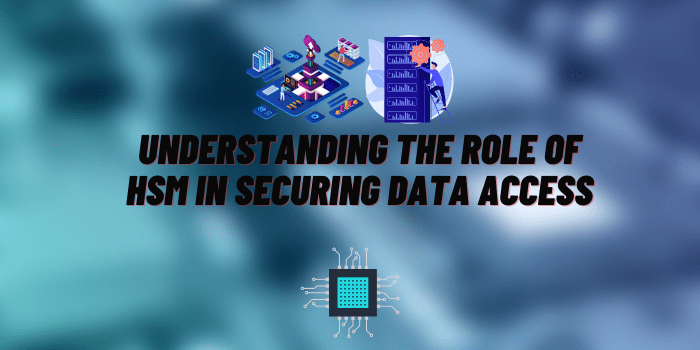Understanding the Role of HSM in Securing Data Access
An HSM, or Hardware Security Module, is a specialized device designed to protect sensitive data by securely storing encryption keys and performing cryptographic operations. It serves as a hardware-based root of trust, ensuring the integrity, confidentiality, and authenticity of data.
One of the primary functions of an HSM is to secure access to sensitive information and cryptographic keys. With its robust access control mechanisms, an HSM establishes secure user access based on roles, preventing unauthorized individuals from tampering with or obtaining sensitive data. This control access ensures that only authorized individuals can interact with the HSM and perform cryptographic functions.
Furthermore, an HSM plays a crucial role in key management. It securely generates, stores, and manages encryption keys, including public and private keys, used for authentication, encryption, and digital signatures. By offloading key management tasks, an HSM provides a secure environment for key material, mitigating the risk of key compromise.
How Does an HSM Work?

An HSM follows a well-defined architecture to ensure data security and integrity. It consists of various components, including a secure processor, secure memory, cryptographic accelerators, and interfaces for integration with applications and systems.
To access the HSM, users must go through a robust authentication and access control process. Role-based access control mechanisms are implemented to enforce user access policies based on organizational requirements. This ensures that only authorized individuals have access to the sensitive functions and data within the HSM.
Key management is a crucial aspect of HSM functionality. The HSM securely generates, stores, and handles encryption keys, ensuring that they are highly protected throughout their lifecycle. This includes secure key generation, key distribution, key usage, and key disposal. By leveraging dedicated cryptographic hardware and secure software, the HSM guarantees the utmost security for key material.
Use Cases for HSM

The use of HSMs extends to various applications and industries, including cloud services, financial institutions, government entities, and healthcare organizations.
In the context of cloud services, AWS CloudHSM is a popular HSM solution offered by Amazon Web Services. It provides customers with a dedicated HSM device in the cloud, allowing them to securely manage their cryptographic keys and perform key operations for their cloud applications.
Another use case for HSMs is secure authentication. HSMs can be utilized to securely store and manage certificates and private keys used for authentication purposes. This ensures that only authorized entities can access sensitive systems or data, providing an additional layer of protection.
HSMs are also essential for cryptographic operations. They offer high-performance hardware acceleration for cryptographic functions, such as encryption, decryption, and digital signing. This enables organizations to efficiently perform cryptographic operations while maintaining the utmost security.
Choosing and Implementing an HSM Solution
When selecting an HSM solution, several considerations should be taken into account. Organizations need to assess their specific security requirements, industry regulations, and integration capabilities with existing systems and applications. It is crucial to choose an HSM that aligns with industry best practices and adheres to security standards such as FIPS 140-2 and PCI DSS.
Once an appropriate HSM solution is chosen, the provisioning and setup process begins. This involves installing the HSM device, configuring user access controls, and integrating the HSM with existing systems and applications. Organizations must follow recommended best practices to ensure a secure and seamless integration process.
Standard Compliance and Certifications for HSM

Compliance with industry standards and certifications is essential for ensuring the security and trustworthiness of an HSM. The FIPS 140-2 standard, issued by the National Institute of Standards and Technology (NIST), governs the security requirements for cryptographic modules, including HSMs. HSMs that are FIPS 140-2 compliant have undergone rigorous testing and evaluation to ensure their security features and functionalities.
Additionally, for organizations handling payment card data, compliance with the Payment Card Industry Data Security Standard (PCI DSS) is crucial. The PCI DSS outlines specific requirements for the secure management of cryptographic keys and the protection of sensitive data. By using an HSM that complies with PCI DSS, organizations can ensure the protection of cardholder information and mitigate the risk of data breaches.
To further enhance data security, organizations must ensure that their HSM solution provides robust mechanisms for data encryption, secure key generation, and secure key storage. Ideally, HSMs should meet or exceed the security requirements specified by FIPS 140-2 Level 3, which guarantees tamper-resistant hardware and strict control over the access to the HSM.
Conclusion
As data security concerns continue to grow, the role of HSMs becomes increasingly important in safeguarding sensitive information and cryptographic keys. An HSM provides a secure environment for key management, access control, and cryptographic operations, serving as a trusted hardware-based solution for organizations across various industries.
By understanding the capabilities and benefits of HSMs, organizations can make informed decisions when selecting and implementing an HSM solution. Compliance with industry standards such as FIPS 140-2 and PCI DSS ensures that the chosen HSM meets the required security and privacy requirements.
Author: Oleg Smirnov from helenix.com






